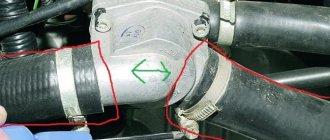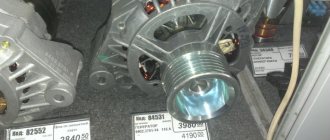Voltage Lada Kalina
- Registration
- Entrance
- To the beginning of the forum
- Forum Rules
- Old design
- FAQ
- Search
- Users
On the forum for 15 years Posts: 143 From: Moscow Car: VAZ 21104-51-27, power steering, Inca gold, 2006 -> Kia Ceed SW 1.6 AT EX + ESP On the forum for 13 years Posts: 45 Car: 21102 2000 On the forum 14 years old Messages: 15417 From: Moscow, SZAO Auto: ff3 On the forum 14 years old Messages: 145 From: Barnaul Auto: 21110 I searched.
There is no definite answer, some say that with increased voltage the battery may boil. According to my BC, when the lights are on and the music is low, the on-board voltage does not rise above 13.5V. It does not rise above 13.5 at all when the engine is running. If you also turn on the heated rear window and the heater at 3-4, it drops to 13.0-12.9V. So what is the range of numbers? So you open the RE, in the section about the BC it says that when the on-board voltage goes beyond the range of 10.8..14.8V the bell starts ringing
On the forum for 14 years Messages: 45 From: Ukraine Car: VAZ 21112 1.6l 8v
Start the engine, let it run for a few minutes, then, pressing the gas pedal, bring the crankshaft speed to 3000 rpm. Turn on all consumers: high beam headlights, heated rear window, heater fan, windshield wiper, hazard warning lights. Measure the voltage at the battery terminals, which should be above 13 V. If this is not the case, the generator windings are faulty (open or short), the voltage regulator with the brush assembly, or the contact rings of the field winding are oxidized. To ensure that the voltage regulator is working properly, turn off all consumers except the high beam headlights and measure the voltage again. It should be within 13.2-14.7 V. The removed voltage regulator can be checked by connecting a lamp (1-5 W, 12 V) between the brushes, and a power source (DC only) to the “D+” and “ground” terminals current!), first with a voltage of 12 V, and then 15-16 V. In the first case, the lamp should light, in the second? No. If the lamp lights up in both cases, in the regulator? breakdown if it doesn’t light up? breakage or broken contact between the brushes and the regulator terminals. In both cases the regulator should be replaced. To check the valves of the rectifier unit, disconnect the wires from the battery, generator and from the “D+” terminal of the voltage regulator. Connect the “plus” of the battery through a lamp (1-5 W, 12 V) to the “B+” terminal of the generator, and the “minus” to its body. If the lamp is on, then there is a short circuit in both the block of “positive” and the block of “negative” valves. To check the short circuit in the “positive” valves, connect the “+” battery through a lamp to the “B+” terminal of the generator, and “-” to the terminal of one of the phase windings of the stator. If the lamp is on, one or more positive valves are broken. To check the short circuit in the “negative” valves, connect the “+” battery through a lamp to the output of one of the phase windings of the stator, and “-” to the generator housing. If the lamp is on, one or more negative valves are broken or the stator windings are shorted to the generator housing. To prevent short-circuiting of the windings, remove the generator from the car and, having disconnected the windings from the voltage regulator and rectifier unit, check their short circuit to ground using a lamp or ohmmeter. The generator valves can also be checked with an ohmmeter without connecting the battery and test lamp.
On the forum for 16 years Messages: 170 From: Elista Auto: 21103
Voltage according to BC, then the weather in Honduras and the terrible button accordion
As with any technology - whatever you come across. My BC shows the same numbers as on the battery terminals. Difference max. was 0.05V. It was measured with some imported (I don’t understand) non-Chinese (like German) tester. Depending on the load from 12.2 to 14.1V. In the morning, when I start it up, it’s 13.8-14.2V, ten minutes later it’s 13.4-13.7V. In the evening (low) 13.2-13.5V At full (all inclusive) 12.7-13.1V
Source
How many volts should the generator produce?
There are two main operating parameters of the device:
- Voltage. This is the voltage in the electrical network, expressed in volts. In modern cars the usual value is 12V, but in Lada Priora it is 14V. If the indicator decreases, electrical appliances fail and the dynamics of the machine decreases. But increasing the parameter leads to worse consequences: wiring and electrical units burn.
- Current strength. It is called the power of the electrical network and is measured in amperes. Depending on the Priora modification, the amperage can be from 80 to 115A, or have other values.
The generator can break down both mechanically and electrically. During current surges, car owners find:
- the pulley is worn out;
- the Priora slip rings or brush assembly are damaged;
- the regulator is burnt out;
- bearings collapsed;
- shorted the winding on the stator;
- the wiring is broken.
If there are problems with the diode bridge, the indicator may also not be stable.
How to replace the relay regulator and generator on Lada Kalina
A three-phase voltage regulator (charging relay) is installed on the generator. Responsible for maintaining the voltage of the on-board network within a given limit in all operating modes.
The output voltage may be affected by changes in rotor speed, electrical load, and ambient temperature.
Failure is considered one of the most common problems associated with the operation of the generator. Replacing an element does not require practical skills.
Let's sum it up
In modern cars, wiring problems are quite common. This is a problem that can actually cause significant trouble. You need to be aware that you should not go on a long journey in a car with electrical problems. Also, you should not continue to operate the machine when such problems have been discovered. And if in one car we are talking about a simple feature of the generator, then in another case it will be important to take into account all the technical aspects of the electrical wiring, each consumer and other factors. Only specialists can deal with these problems.
The cost of repairing the electrical network at a good service station will depend on the causes of the breakdown. Sometimes it is enough for specialists to replace a failed relay to correct the situation. Otherwise, it is necessary to repair the generator, change or remove certain electrical consumers from the system. Therefore, the final costs depend on the problems identified during diagnosis. It is important to remember that any problems should be corrected quickly enough, otherwise problems with the vital organs of your car may occur. Have you ever encountered such problems?
The generator must always be in good working order
Any modern car is equipped with electrical equipment that is absolutely necessary for the vehicle:
- without a starter it is impossible to start the engine;
- a car cannot be driven without lighting at night;
- The heater motor creates heat in the cabin;
- The wiper motor clears the windshield of rain and snow;
- FM radio makes it possible for the driver not to get bored on the road.
But all these devices cannot work without electricity, so the car must have a power source.
The current from which all consumers in the car are powered is produced by the generator, and the performance of the entire electrical circuit of the vehicle depends on its condition.
Therefore, the generator must always be in good working order, and if any breakdowns occur with it, they must be eliminated in a short time.
Generator Lada Kalina
Lada Kalina cars are equipped with three-phase generators that produce alternating current; to produce direct current, a rectifier unit is included in the generator circuit.
AvtoVAZ equips VAZ 1118 cars with generators of the type 5132.3771
or 9402.3701-06
, there are many different manufacturers producing spare parts for VAZ cars.
The generator for the Lada Kalina can be of different power; the industry produces current sources of 85, 100, 90, 115, 120, 135 Amperes.
Among the most famous manufacturers of VAZ parts are:
- Pramo;
- StartVOLT;
- KZATE;
- LKD (China);
- Eldix (Bulgaria);
- ISKRA (Slovenia);
- BATE (Belarus);
- Bosch.
Why does the battery run out: did the patient sweat before dying?
Why does another battery give out after working for only a year or two? In a car, it is charged from a generator - at a constant voltage in the on-board network. After starting the engine, intensive charging lasts only a few minutes (this is called accelerated charging). The current at the beginning of the charge can reach tens of amperes, but then throughout the entire trip it is close to zero. With this “lifestyle”, the battery is constantly undercharged, large insoluble lead sulfate crystals form on the plates - they increase the internal resistance of the battery, and its capacity becomes less and less with each cycle.
Let us remind you that a battery whose terminal voltage has dropped to 10.2 V is considered completely discharged, since at less it will begin to deteriorate. But such a battery can easily start a working engine in the summer! It’s a different matter after a night in the cold; nothing will come of it for sure.
Often the batteries that are the leaders in advertising tests only work at C levels and don’t last long. This is partly due to the way they are charged before testing: using direct current allows you to achieve 100% compliance with the declared capacity. In this case, the voltage at the end of the charge can exceed 16 V. You will not find this in a working car. For example, on our “ten” there were both 13.2 and 14.7 V. The first may well kill any test winner! For the newest batteries, as a rule, a charging voltage of at least 15.1 V is required (as, for example, on Kalina). But some (the simpler and heavier ones) sometimes serve their owners for many years; seven or eight years is not so uncommon! Domestic ones, by the way, are made in such a way that they charge perfectly at a voltage of 14.5 V.
Step-by-step procedure for checking the generator
- Turn on the ignition and make sure that all the dashboard lights are on.
- We start the car, and if the generator is operating normally, the battery warning light should go out.
- We wait until the car warms up to its standard operating temperature of 90 °C.
- When it warms up, it is necessary to load the network as much as possible. To do this, we turn on everything that is in the car, including heated mirrors, lights, music, etc.
- We take a pre-prepared multimeter and set it to the “voltage” check mode.
- Next, we call an assistant and ask him to keep the engine speed at idle (within 3500 - approx.).
- Using a multimeter, we connect its probes to the battery, and at the moment when all consumers are turned on, the readings should not fall below - 13-13.2 V.
If the readings are lower at such engine speeds, this will indicate that the generator is not producing the required amount of energy. And when they are normal, we continue testing with switched off consumers at the same speed. In this case, the multimeter readings should be about 14.5-14.7 V.
Checking the voltage supplied by the generator
After diagnosing the battery, we go directly to the generator using the same multimeter.
- When the car is started, we connect the probes to its terminals, and the voltage should be at least 14-14.3 Volts.
- Next, as the speed increases, we monitor the instrument readings, where the values should not change by more than 0.5 volts. If this is not observed, this will mean that the generator and voltage regulator are functioning correctly.
There is an excess of overvoltage in the network.
Now, having reliable information about how many volts the generator should produce, you will know for sure whether it is working or not. And if the readings differ slightly from the norm, then first of all you should pay attention to the malfunctions described below.
Device
The Lada Kalina generator consists of the following parts:
- housing (front and back cover);
- pulley;
- stator windings;
- armatures (rotor);
- voltage regulator relay (charging relay);
- diode bridge (rectifier unit);
- two armature bearings;
- rear plastic casing.
Inside the generator housing, along its walls there is a stator with a winding, and a rotor is located in the center.
At the back of the case there is a diode bridge and a voltage regulator relay; the diode bridge is covered with a plastic casing to prevent dirt and dust from entering.
There is a pulley in front of the housing; it is put on the rotor shaft and secured with a nut.
The generator is driven by a drive belt placed on a pulley.
Signs of a faulty voltage regulator
The stabilizer is responsible for the constant current received by the auto electrician. In the recent past, the regulator was electromagnetic, now it is an electronic semiconductor. This type of relay causes unstable voltage in the standard Priora network.
The generator produces low voltage
The reason for the low voltage is sought in the generator brushes (they often wear out). The device can also short out to the body, and sometimes it happens that the circuit is simply broken.
You can notice a reduced value of the on-board current by dim headlights, turning off some devices (for example, a radio), and rapid battery discharge.
Power surges
If the graphite brushes on the Priora are not in order, the unit produces increased current. Signs:
- fuses of certain electricity consumers are burning;
- the voltage indicator arrow on the instrument panel is shaking;
- headlights flash;
- the engine "jerks"
The culprits of the phenomenon, in addition to brushes, are weak contacts in the circuit, breakdowns in the “power plant” of the Priora.
The generator does not produce current
This is indicated by a constantly lit battery error icon. The driver should ring the wires, check the diode bridge and the integrity of fuse links F4, F6.
- graphite brushes are worn out;
- the voltage regulator has failed;
- The stator or rotor windings have burned out.
Damaged generator bearings will also interrupt the supply of current to the network.
Malfunctions
All generator malfunctions can be divided into two categories:
- lack of charging (or undercharging);
- increased noise.
A whistling or grinding noise may be caused by bearings or tension belts.
The reason for poor charging or its complete absence may be:
- break or short circuit in the rotor or stator winding;
- wear of the brushes (they are located in the same housing with the relay regulator);
- charging relay malfunction;
- breakdown of the diode bridge;
- loose belt.
Vehicle voltage
For normal operation of all consumers in the car, the generator must maintain a certain voltage; for the Lada Kalina on-board network, with a working generator, it must be in the range from 13 to 14.8 volts.
Within specified limits, the voltage is provided by a relay regulator, and with any deviation from the specified norm, various problems arise:
- At high voltage, the electrolyte in the battery banks boils, and the battery quickly fails;
- If there is insufficient charging, there is not enough current for consumers, as a result the battery quickly discharges.
The voltage generated by the current source is measured in the following way:
- On a digital multimeter (voltmeter), set the limit to 20 volts;
- We connect the probes of the measuring device to the battery and start the internal combustion engine, the voltmeter should show a voltage of about 14 volts;
- Without turning off the engine, we turn on the load - headlights (high beam), heater motor at maximum speed, windshield wipers, radio, etc. If the generator is in good condition, when the engine is idling, the voltage should not fall below 13.2V, optimal The voltage is considered to be 13.7-13.9 V.
POPULAR WITH READERS: New Lada Xray in Russia
Diagnostics of the relay regulator
Checking the relay regulator when recharging the battery is not a complicated procedure and you can do it yourself using a multimeter.
The test comes down to measuring the voltage at the battery terminals under different operating modes of the power plant. That is, we simply connect the multimeter probes to the terminals and measure the voltage first at XX, then at medium speeds, and then at high speeds.
At idle, the normal voltage is 13.2-14.0 V, at medium speeds - 13.6-14.2 V, at high speeds - up to 14.5 V.
If the values exceed the specified values, you should check and clean the contacts of the charging system circuit and repeat the procedure again.
If cleaning does not help, we check the relay separately (removed from the car), but for this you will need a power source with regulated voltage (you can use a battery charger), as well as a regular 12 V lamp.
The essence of the test is this: we connect the negative wire from the charger to the housing, and connect the positive wire to the regulator terminal. The lamp is connected to graphite brushes (polarity is not important).
When checking, we first set the voltage at the source to 12.7 V, at which the lamp should light up. We gradually increase the value to 14.5 V. When the specified value is reached, a working regulator should operate and the lamp will go out.
If it continues to light when exceeding 14.5 V, then the unit is faulty and requires replacement.
Checking the rectifier unit (diode bridge)
To perform this diagnostic, it is necessary to remove the diode bridge from the Kalina generator; this was described in more detail in previous articles in this section.
Then we connect the tester with the black wire to the negative plate of the block, and the red one in turn to the three contact terminals of the diodes. This way we check all the rectifiers in the block. The values on the device should be in the range from 400 to 800 Ohms. Personally, on my Kalina, during this test, all diodes showed a resistance within 535 Ohms. But the repair instructions from the Third Rome publishing house talk about numbers of 580-620 Ohms. I will say right away that when I rang two serviceable generators, the values specified in the manual were not achieved, although there were no problems with charging, so I personally doubt the accuracy of the data in this instruction.
Then we carry out the same operation, only swapping the contact wires of the multimeter. In this case, the device, with working diodes, will show infinity, that is, its readings will not change:
Brush wear
As the generator brushes wear out on the Lada Kalina, charging begins to disappear - the indicator of insufficient battery charging periodically lights up (blinks) on the instrument panel.
The brush assembly of the VAZ 1118 generator is located in the relay-regulator, so the entire part is changed entirely.
The wear of the brushes can be easily measured - they must have a minimum length of at least 5 mm.
Replacing the charging relay
If the charging relay is faulty, the voltage in the car's network can be too high or too low, and the voltage can also “jump”.
To eliminate the malfunction, it is necessary to change the relay regulator. On the Lada Kalina, this part is easy to replace with your own hands; the replacement can be made without removing the generator itself:
- turn off the engine, open the hood and remove the negative terminal from the battery;
- on the back side of the generator, pull off the top chip with the wire, unscrew the nut securing the supply wires and disconnect the wires themselves;
- remove the plastic casing, the cover can be removed easily - you need to unclip three hooks. If the casing is difficult to remove, it can be removed by hooking it with a screwdriver between the generator body and the plastic cover;
- unscrew the two bolts securing the relay regulator (key 8), disconnect the chip with the wire and dismantle the part;
- install the new charging relay in place and assemble everything in the reverse order.
How to check the generator voltage on a Priora
A household voltmeter will help in checking the voltage in the network.
How to use:
- Start and warm up the Priora engine.
- Turn on all peripheral electrical devices.
- Increase the speed of the power unit to 2500 rpm.
- Apply probes to the voltage and terminals B+ of the “power station” of the machine. Or measure the current with a multimeter.
The reading on the voltmeter is 13.8-14.4 V – normal. Now turn off all devices and measure the parameter again. With a reading of 14.5 V you can drive safely. If there is a deviation in any direction, diagnose the part.
Regulator replacement
You can do simple work yourself. A new voltage relay (RN) will be required. Choose a modern type regulator that smoothly increases the load on consumers. This is a reliable multifunctional PH 844.3702 of domestic production. This relay can be installed on cars older than 2012.
Prepare your tools: keys of different sizes, 10-mm wrenches, screwdrivers. Read more about replacing the voltage regulator.
Progress
To replace a spare part, you can remove the entire installation, which will make the work easier, or you can not remove the generator, but then some dexterity will be required.
If you chose the first method, your actions after removing the node:
- Remove the PH cover and plug.
- Unscrew the clamps (2 pcs.).
- Unscrew the bolt holding the defective element.
- Remove the old regulator.
- Install the new part, connect it.
- Assemble and put everything in place.
If you do not remove the electromechanical unit, the air filter will interfere with access to the unit - move it. Watch a detailed video review on the topic on the YouTube channel.
On a starvation diet
Until recently, charging was controlled with an ammeter, but what's the point? The needle deviated only after starting the engine, and then firmly fell to zero! Later, this uninformative device was replaced by a voltmeter with colored sectors of the scale: an arrow in the green zone is normal, in the yellow zone the charge is weak, and in the red zone no, no! Later, the voltmeter was also abolished, replaced by a light bulb with a battery symbol. When you turn on the ignition it lights up, after starting the engine it goes out... and that's it. It is of little use as a control device. There may be no charging (for example, the alternator belt is loose or the contact on the wire from the alternator to the battery is lost), and the light will not light up and not warn! The standard on-board computer will also come to its senses no sooner than the voltage drops below normal.
Other causes of low voltage
A small potential difference in the system is not always associated with a breakdown of the generator or a bad battery. If the diagnosis of these elements does not reveal any problems, then you should pay attention to the following:
- condition of the battery terminals - connection density and oxidation;
- electrical wiring problems - oxidation, violation of its integrity;
- output contacts to electrical appliances;
- correctly selected energy consumers.
Each contact must be tightly adjacent and intact, that is, there must be no formations (for example, sulfation) that will disrupt the flow of current. Incorrect connection of contacts leads to accelerated battery discharge even when the car is not running.
To improve the connection of the elements of the car's electrical system, it is necessary to clean all contacts and restore the integrity of the wires by replacing them or connecting them and wrapping them with insulating tape.
In conclusion, I would like to repeat that stable operation of the car requires constant monitoring of all elements, and the generator should attract special attention. The battery is charged from it and provides electricity to the entire car system. Pay attention to all elements: generator brushes, slip rings, voltage regulator, equipment winding.
The most correct measurements should be carried out when the battery is fully charged and in various modes. Remember that the manufacturer links the characteristics of the generator to the number of engine revolutions - they help produce a certain current.
Detailed video on how to check the generator:
Do you have experience diagnosing an alternator and solving problems in a vehicle's electrical system? Please share your experience and opinion with our readers in the comments. If you have questions about the topics covered, we will be happy to answer them.
Source: akkumulyatoravto.ru
Generator replacement
In cases where the damage to the generator is serious (for example, the stator and rotor burned out at the same time), sometimes it is easier to replace the entire assembly than to repair the device.
Replacing the Lada Kalina generator is not difficult, almost any driver can do it, but it is better to do the work on an inspection pit or a car lift.
We make the replacement as follows:
- we stop the engine, remove the terminal from the battery (ground);
- if there is protection under the engine, remove it;
- Disconnect all wires from the generator;
- Use the tensioner bolt to loosen the generator belt and remove it;
- we unscrew the generator itself, it is attached to two bolts - one of them is unscrewed from above, the other from below;
- We take out the old generator and install a new one, putting everything back together in reverse order.
How to replace a generator set?
How to remove the generator? In some cases, repairing the generator unit is impractical or cannot restore the functionality of the device.
Replacement is required here. The process itself is not an intricate undertaking, so it will not take much time from the owner of the Lada Kalina.
For a successful replacement operation we will need:
- Remove the belt, first loosening the tension element.
- Disconnect the plug together with the cable terminals.
- Unscrew the nut securing the upper section of the unit and remove the bolt.
- Use the same method to remove the bolt at the bottom of the device.
- Remove the generator unit from the engine compartment.
Replacement and installation of a new device is carried out using the reverse algorithm.
Source
Granta, Kalina Priora
On front-wheel drive LADA cars (Priora, Kalina Granta), the ground wire from the negative terminal of the battery is attached to the thermostat housing. This is a bad decision because... The thermostat is isolated by a gasket and all current flows through two studs. During operation, the contact oxidizes and the voltage in the on-board network drops, difficulties appear in starting the engine, etc. The problem can be solved with a simple modification.
You should move the negative wire coming from the battery from the thermostat to the engine:
Or install an additional wire from the thermostat to the engine (photo diamond1309):
It would not be a bad idea to additionally extend the ground from the negative terminal of the battery to the body and generator:
Normal voltage
What should be the normal voltage in the on-board network? The voltage in the vehicle's 12 V on-board network should be 14.2-14.4 Volts. This applies to all vehicles, from Zaporozhets to Gelendvagens. This parameter should be present when the engine is running under load.
If there is a voltage drop caused by insufficient battery charge at 12 volts, then when you turn on, for example, optics, this parameter will be below 14 volts. This is because the excitation winding of the generator device is powered by the battery through feedback. And if the battery is not fully charged, the network will not be able to ensure optimal winding current and normal operation of the generator device.
This manifests itself when outdoor lighting is activated and is accompanied by a general loss of electrical circuit power. The lighting may be dim when idling, but when the driver accelerates, the light will stabilize to normal. Therefore, battery diagnostics should be carried out not by voltage when starting the engine, but by the electrolyte density parameter. This will prevent a difference in readings between the electromotive force of the battery and its current.
Note that the voltage of the vehicle’s on-board network may vary depending on the climatic conditions of the region in which the vehicle is operated. If the car was driven from the south, and you live in the north, then a slight drop in this indicator in the car’s electrical circuit is allowed. If a vehicle is using a partially discharged battery, it must be charged, otherwise the entire charge will quickly decrease and the battery will be inoperable. If an old battery is used in a car, over time the active mass from the plates may begin to disintegrate and a short circuit may occur inside the structure. And this will cause a loss of capacity, that is, the ability to keep the battery charged.
The on-board voltage in the vehicle network should be from 14.2 to 14.4 volts with the engine turned on and energy consumers activated. Diagnosis of this indicator should be carried out at the battery terminals, and not at the terminals of the generator device.











